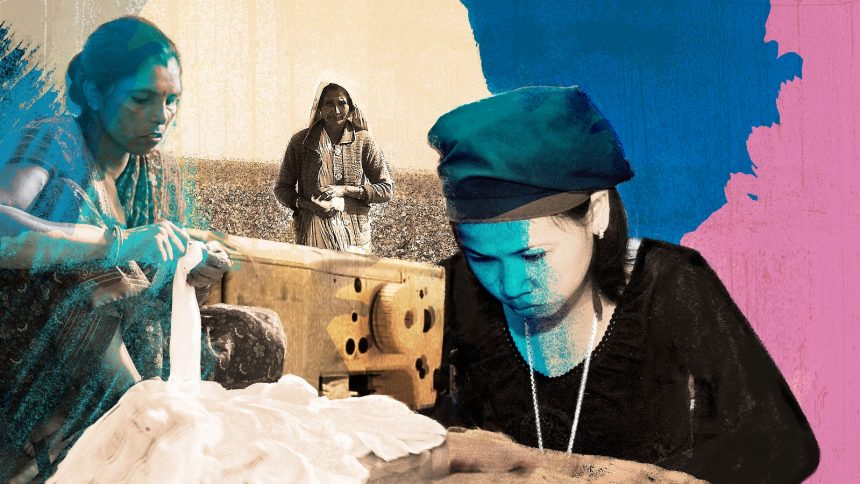This story is published in partnership with The Fuller Project. As Nour feeds another half-finished pair of pants through her sewing machine, her arms begin to shake. Amid the whir of fans, her T-shirt sticks to her like skin. She fights to focus, knowing full well her target of up to 100 pieces an hour isn’t going to hit itself.
“I am completely soaked in sweat,” the 38-year-old says of her work shifts. “The heat makes me exhausted.” Nour, who asked to use a pseudonym out of fear of reprisal from her employer, works at Yakjin, a South Korean-owned garment factory in Cambodia. More than 2,500 employees here stitch apparel for major U.S. giants like Walmart and Gap. Workers at Yakjin say the heat often leads to near-fainting episodes, fatigue, and dehydration. With no windows, the air feels stifling but their requests for fans are at times ignored.
Workers at three other factories in Phnom Penh, the country’s capital, producing clothes for brands like Primark, H&M, and Old Navy (owned by Gap Inc.), told similar stories of worsening heat. Around the world, fashion’s mostly female labor force is grappling with working conditions made increasingly unbearable and unhealthy by climate change. Women picking cotton in India’s sun-baked fields are toiling in temperatures of roughly 113 degrees Fahrenheit, while workers in Ghana’s Kantamanto — one of the world’s largest second-hand markets where clothing discarded by Western consumers is resold — are losing vital wages when flooding prevents trade. Nour is just one of nearly 1 million garment workers in Cambodia, a country that has experienced roughly 1.4 degrees F degrees of warming per decade since the 1960s.
Employees work at a garment factory in Phnom Penh, Cambodia in 2021. Ouyang Kaiyu/China News Service via Getty Images Fashion has had a devastating impact on the planet, producing more greenhouse gas emissions than aviation and shipping combined. So far, labor experts say, the more than $2.5 trillion industry has mostly focused its climate change efforts on mitigation, such as using more recycled fabrics, while largely ignoring how it impacts workers.
“[Labor] violations in factories are so gross, as in so widespread, and so awful… that that’s where the attention has been,” said Liz Parker, an associate member of Clean Clothes Campaign, an Amsterdam-based alliance of labor unions and nongovernmental organizations. “But workers are suffering from heat stress, from flooding, from water pollution…and we need to protect [them] from that as well.”
To expose how climate change is impacting workers throughout fashion’s supply chain, The Fuller Project tracked products from several brands — including Walmart, Primark, H&M, Gap, and Old Navy — across several countries. At each stage, women play a vital role in the global business of fashion yet their livelihoods — and lives — are being increasingly threatened by extreme weather.
Cotton fields appear outside the car window an hour into the drive from Ahmedabad, capital of Gujarat state on India’s western coast. In every field, a woman in a sari is scooping cotton blossoms into a bag, spots of bright color that punctuate green fields topped with white fluff.
Roshan Osmanbhai arrives at 7 a.m. daily and ties a strip of cloth around her head to protect it from the sun. By midday, the temperature will hit more than 80 degrees F. The last week of January is supposed to be the height of winter in Gujarat, with average temperatures hovering around 68 degrees F. She hasn’t felt that traditional winter for years.
India is the world’s biggest grower of cotton after China. Six million farmers make a living from the sector, most of them women, according to Better Cotton, a nonprofit that promotes sustainable production. Cotton’s global supply chain is complex and lacks transparency, but Primark and H&M both confirmed they source from India. Walmart, Gap, and Old Navy didn’t respond to The Fuller Project’s requests for comment, but nonprofits monitoring supply chains said they likely do as well.
“If you’re in the apparel business…you have to come here,” said Ashis Mondal, former director of Action for Social Advancement, an Indian nonprofit supporting small farmers. “You have no other option.” Across the region, the farms might be run by women, but few of them own the land they cultivate. The precarious nature of their work is exacerbated further by the changing climate, with summers arriving earlier and monsoon rains delayed or declining, damaging crops. India recorded extreme weather events on nearly 90 percent of the days in the first nine months of 2023, according to The Centre of Science and Environment, a research organization based in New Delhi, killing nearly 3,000 people and ruining almost 5 million acres of crop area.
A woman picks cotton in Maharashtra, India in 2022. Godong/Universal Images Group via Getty Images In Gujarat last year, summer rolled in before March, say the women. The temperature shot up to roughly 113 degrees F before anybody knew what to do. Women farmers complained the heat was making it hard to carry on. “The heat makes our skin itch,” said Jessuben Jhapra, a 49-year-old farmer. “Heat rash can erupt all over the body. Our eyes are under enormous strain.” The weather patterns have invited new and unfamiliar pests, requiring pesticides that have created further health problems for the women. Most own protective gear — gloves, boots, goggles — but don’t always use them when it’s hot. Two years ago, Alayben Zilriya, a 55-year-old farmer with sharp cheekbones and thin-rimmed spectacles, sprayed pesticides on the plants using her bare hands. She got such a severe reaction that she had to visit the doctor for treatment. Today, the skin on her hands is still shriveled, her nails grayish.
Excessive temperatures can do serious harm to humans. Heat exhaustion sets in when too much water and salt is lost, usually due to excessive sweating. Symptoms include nausea, dizziness, thirst, and palpitations. It can be hard to think clearly — hot weather is linked to reduced cognitive function, judgement errors, and higher risk of occupational injury. For Nour, this sounds familiar. Even though drinking water is available at her factory, she feels dehydrated and has little energy to work. When it’s hot she takes more toilet breaks but misses her hourly targets and says her supervisors at Yakjin become verbally abusive.
“They curse or insult us,” she explained. “They blame us.”
Workers at Yakjin interviewed by The Fuller Project said they often feel ill or faint. Ry, 38, who has been employed at the factory for over a decade, thinks the heat is getting worse. Climate change is part of the problem, he says, but also fans aren’t maintained or replaced. While the building has fans that blow mist to keep workers cool, they do not reach all employees. For over two years, Ry has asked the factory for more, but says his requests have fallen on deaf ears.
Only a small handful of Cambodia’s roughly 1,300 garment factories have air conditioning, according to Seang Yot from The Coalition of Cambodian Apparel Workers’ Democratic Union, or C-CAWDU.
At lunchtime, Yakjin employees hang cloth above their heads in the outdoor canteen for extra shade. In heavy rains during the wet season, the area floods, as does the factory, workers tell The Fuller Project. Cambodia is already highly vulnerable to flooding, including flash flooding, but projected climate change trends indicate this is only set to get worse — affecting tens of thousands more people each year by 2030. Workers are concerned about electric shocks as flood water comes in contact with the factory’s electrical systems, said Nour, though no one has been hurt yet.
“Anything involving money is always a problem,” explained Ry, who also asked to use a pseudonym. “The factory managers don’t care about how heat impacts us, only that we speed up and work faster.” In an email, Yakjin Cambodia’s management said the factory maintains “a comfortable indoor temperature with cooling and ventilation systems,” including fans and air conditioners, but said there was no AC in the sewing line.
They said there have been no reported cases of fainting in the past two years, and that exhaustion could have many causes including inadequate healthcare, exercise, and lack of sleep, as well as heat. There are grievance mechanisms in place for workers and no one had reported supervisors becoming verbally abusive when production targets…






